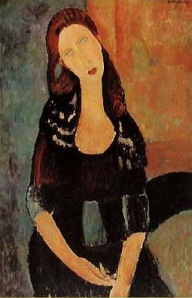I wrote this piece for one of my classes, but I thought it was too interesting to not share with you all. I hope you enjoy it and learn something new about art forgery.
One of the best ways to learn how to be a great artist is to copy the masters. How did Van Gogh do this? Or Matisse do that? Some of the best artists learned by copying the masters and then breaking off into their own styles. But, this practice of replicating style and ideas also opens up the world to a sinister and disliked practice. Forgery.
When an artist becomes famous, it is obvious that people will want to replicate what he has done; not only to learn how he created that masterpiece but to also try to make a profit. Let’s start out with a little test. Which of these paintings is a real Modigliani and which is fake? It is tough to tell. Now, no cheating and looking it up on the Internet.
So, how do we recognize forgeries? Usually a forgery is recognizable because the artist is often less experienced, and honestly, less talented than the true artist. Often, there just seems something not quite right in the painting’s composition. There are usually small stylistic errors that are obvious if you are familiar with the true artist. As well, looking at the linear composition of the painting can help you figure it out.
One other famous forger is Hans Van Meegeren. He created dozens of “Vermeer” paintings and sold them for profit. Which one of these is Van Meegeren and which is Vermeer?
Think about that and I will give you the answer to the first question. Both paintings are very similar; I could believe that they were made by the same painter. If you guessed the one on the right is real, you are correct. In addition, I will tell you how you can figure it out. On the left, look closely at the brush strokes. Especially in the background you can sense that they were planned and painstakingly done. There is not that hurried free form feeling which is present on the real painting. Also, look at the eyes. Neither woman is truly making eye contact, but on the right there is an intensity that is lacking on the left.
Lastly, I want to look at the linear composition. I will first talk about the fake, on the left. Follow the hand from the elbow up to the face and to the finger. The elbow leads your eye into the painting, the finger shoves you right back out. As well, look at the line from the left side of her face to her collar. Neither continues and this makes the painting seem awkward. Now look at the real painting. The lines are soft, they allow your eye to explore the painting without leading you away from the figure. The most important detail in this painting is the girl’s earring. Look at how it is tilted. There is a reason for that. The line of the earring leads the viewer’s eye to her shoulder which leads us down the painting, to her hand and then to her other arm, which leads us right back up again to her face. Brilliant, right? So now do you think you can tell a forgery from a real painting?
Take a look at the Vermeer paintings again. Take another guess. Ready? The real one is on the right. Vermeer was not only a master of lines, but of light as well. Look at how warm the light is in his painting. It highlights the girl’s face, the background and her torso. However, if you were not looking for it you probably would not have noticed it. The colors are warm brown and neutral tones, unlike the unpleasant cold blues that are used in the fake painting.
Lastly, the most important aspects of the Vermeer paintings are the lines. Look at the chair in the bottom left corner of the real painting. That is the anchor point for the viewer. The chair stops your eye from leaving the painting and brings you back up to the woman. (There is very subtle highlighting diagonally from the top of the chair to her face.) When you look at the true Vermeer painting, you cannot stop looking at the woman. She is obviously the focus of the painting and it is difficult to pull your eyes away from her. Compare this to the woman in the fake Meegeren painting. The blue tones on her face almost make her skin look dead. If you follow the line of her back and torso, they curve downward leading your eye directly out of the painting. There is nothing keeping you interested in looking at her, or anything else in the painting.
I hope you enjoyed the guessing game! How many of you got it right?



I’m fascinated with the idea of forgery. Why would an artist talented enough to create a good fake want to do that rather than create his or her own work? Reminds me of “The Moderns,” one of my favorite movies ever–1920s Paris with Hemingway, Gertrude Stein and others, plus the art forger played by Keith Carradine. Makes me want to see it again!
I love the weightiness at the bottom of the piece on the right and the negative spaces in the openings of that chair!
And my guess is that the real Modigliani is on the right. (Where’s the neck on the girl on the left?) I also love that black curvilinear shape to the girl’s right.
Page, as your friend, honorary auntie and former grade school art teacher, I am very proud of you!